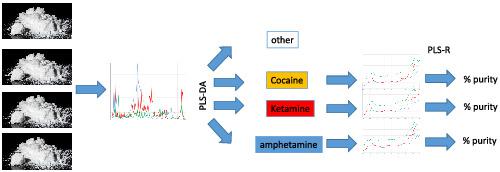当前位置:
X-MOL 学术
›
Drug Test. Anal.
›
论文详情
Our official English website, www.x-mol.net, welcomes your feedback! (Note: you will need to create a separate account there.)
An infrared spectroscopic approach to characterise white powders, easily applicable in the context of drug checking, drug prevention and on‐site analysis
Drug Testing and Analysis ( IF 2.9 ) Pub Date : 2020-11-16 , DOI: 10.1002/dta.2973 Eric Deconinck 1, 2 , Camille Aït-Kaci 1, 2 , Andries Raes 1 , Michaël Canfyn 1 , Jean-Luc Bothy 1 , Céline Duchateau 1, 2 , Corenthin Mees 2 , Kris De Braekeleer 2 , Lies Gremaux 3 , Peter Blanckaert 3
Drug Testing and Analysis ( IF 2.9 ) Pub Date : 2020-11-16 , DOI: 10.1002/dta.2973 Eric Deconinck 1, 2 , Camille Aït-Kaci 1, 2 , Andries Raes 1 , Michaël Canfyn 1 , Jean-Luc Bothy 1 , Céline Duchateau 1, 2 , Corenthin Mees 2 , Kris De Braekeleer 2 , Lies Gremaux 3 , Peter Blanckaert 3
Affiliation

|
More and more events, such as the summer music festivals, are considering the possibilities for implementing on‐site testing of psychoactive drugs in the context of prevention and harm reduction. Although the on‐site identification is already implemented by plenty of drug checking services, the required rapid quantitative dosing of the composition of illicit substances is still a missing aspect for a successful harm reduction strategy at events. In this paper, an approach is presented to identify white powders as amphetamine, cocaine, ketamine or others and to estimate the purity of the amphetamine, cocaine and ketamine samples using spectroscopic techniques hyphenated with partial least squares (PLS) modelling. For identification purposes, it was observed that mid‐infrared spectroscopy hyphenated with PLS‐discriminant analysis allowed the distinction between amphetamine, cocaine, ketamine and other samples and this with a correct classification rate of 93.1% for an external test set. For quantitative estimation, near‐infrared spectroscopy was more performant and allowed the estimation of the dosage/purity of the amphetamine, cocaine and ketamine samples with an error of more or less 10% w/w. An easily applicable, practical and cost‐effective approach for on‐site characterisation of the majority of the psychoactive samples encountered in Belgian nightlife settings based on IR spectroscopy was proposed.
中文翻译:

一种表征白色粉末的红外光谱方法,易于应用于药物检查、药物预防和现场分析
越来越多的活动,例如夏季音乐节,正在考虑在预防和减少危害的背景下实施精神药物现场检测的可能性。虽然现场识别已经通过大量药物检查服务实施,但需要对非法物质的成分进行快速定量给药仍然是活动中成功减少危害策略的一个缺失方面。在本文中,提出了一种方法来识别白色粉末为苯丙胺、可卡因、氯胺酮或其他,并使用光谱技术与偏最小二乘法 (PLS) 建模相结合来估计苯丙胺、可卡因和氯胺酮样品的纯度。出于识别目的,据观察,中红外光谱与 PLS 判别分析相结合,可以区分安非他明、可卡因、氯胺酮和其他样品,并且外部测试集的正确分类率为 93.1%。对于定量估计,近红外光谱的性能更好,可以估计安非他明、可卡因和氯胺酮样品的剂量/纯度,误差大约为 10% w/w。提出了一种易于应用、实用且具有成本效益的方法,用于基于红外光谱对比利时夜生活环境中遇到的大多数精神活性样本进行现场表征。近红外光谱的性能更高,可以估计安非他明、可卡因和氯胺酮样品的剂量/纯度,误差大约为 10% w/w。提出了一种易于应用、实用且具有成本效益的方法,用于基于红外光谱对比利时夜生活环境中遇到的大多数精神活性样本进行现场表征。近红外光谱的性能更高,可以估计安非他明、可卡因和氯胺酮样品的剂量/纯度,误差大约为 10% w/w。提出了一种易于应用、实用且具有成本效益的方法,用于基于红外光谱对比利时夜生活环境中遇到的大多数精神活性样本进行现场表征。
更新日期:2020-11-16
中文翻译:

一种表征白色粉末的红外光谱方法,易于应用于药物检查、药物预防和现场分析
越来越多的活动,例如夏季音乐节,正在考虑在预防和减少危害的背景下实施精神药物现场检测的可能性。虽然现场识别已经通过大量药物检查服务实施,但需要对非法物质的成分进行快速定量给药仍然是活动中成功减少危害策略的一个缺失方面。在本文中,提出了一种方法来识别白色粉末为苯丙胺、可卡因、氯胺酮或其他,并使用光谱技术与偏最小二乘法 (PLS) 建模相结合来估计苯丙胺、可卡因和氯胺酮样品的纯度。出于识别目的,据观察,中红外光谱与 PLS 判别分析相结合,可以区分安非他明、可卡因、氯胺酮和其他样品,并且外部测试集的正确分类率为 93.1%。对于定量估计,近红外光谱的性能更好,可以估计安非他明、可卡因和氯胺酮样品的剂量/纯度,误差大约为 10% w/w。提出了一种易于应用、实用且具有成本效益的方法,用于基于红外光谱对比利时夜生活环境中遇到的大多数精神活性样本进行现场表征。近红外光谱的性能更高,可以估计安非他明、可卡因和氯胺酮样品的剂量/纯度,误差大约为 10% w/w。提出了一种易于应用、实用且具有成本效益的方法,用于基于红外光谱对比利时夜生活环境中遇到的大多数精神活性样本进行现场表征。近红外光谱的性能更高,可以估计安非他明、可卡因和氯胺酮样品的剂量/纯度,误差大约为 10% w/w。提出了一种易于应用、实用且具有成本效益的方法,用于基于红外光谱对比利时夜生活环境中遇到的大多数精神活性样本进行现场表征。



























 京公网安备 11010802027423号
京公网安备 11010802027423号